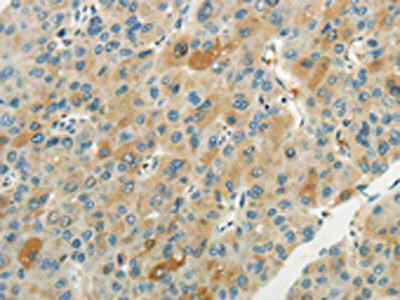Description
| Antibody Name: | WNT2B Antibody (PACO20914) |
| Antibody SKU: | PACO20914 |
| Size: | 50ul |
| Host Species: | Rabbit |
| Tested Applications: | ELISA, IHC |
| Recommended Dilutions: | ELISA:1:1000-1:2000, IHC:1:10-1:50 |
| Species Reactivity: | Human, Mouse |
| Immunogen: | Synthetic peptide of human WNT2B |
| Form: | Liquid |
| Storage Buffer: | -20°C, pH7.4 PBS, 0.05% NaN3, 40% Glycerol |
| Purification Method: | Antigen affinity purification |
| Clonality: | Polyclonal |
| Isotype: | IgG |
| Conjugate: | Non-conjugated |
 | The image on the left is immunohistochemistry of paraffin-embedded Human liver cancer tissue using PACO20914(WNT2B Antibody) at dilution 1/20, on the right is treated with synthetic peptide. (Original magnification: x200). |
| Background: | This gene encodes a member of the wingless-type MMTV integration site (WNT) family of highly conserved, secreted signaling factors. WNT family members function in a variety of developmental processes including regulation of cell growth and differentiation and are characterized by a WNT-core domain. This gene may play a role in human development as well as carcinogenesis. Alternative splicing results in multiple transcript variants. |
| Synonyms: | wingless-type MMTV integration site family, member 2B |
| UniProt Protein Function: | WNT2B: Ligand for members of the frizzled family of seven transmembrane receptors. Probable developmental protein. May be a signaling molecule which affects the development of discrete regions of tissues. Is likely to signal over only few cell diameters. May be involved in normal development or differentiation as well as in carcinogenesis. Belongs to the Wnt family. 2 isoforms of the human protein are produced by alternative splicing. |
| UniProt Protein Details: | Protein type:Secreted, signal peptide; Secreted Chromosomal Location of Human Ortholog: 1p13 Cellular Component: extracellular space; proteinaceous extracellular matrix; extracellular region Molecular Function:frizzled binding Biological Process: neuron differentiation; lens development in camera-type eye; Wnt receptor signaling pathway; cell fate commitment; male gonad development; chondrocyte differentiation; Wnt receptor signaling pathway through beta-catenin; forebrain regionalization; cellular response to starvation |
| NCBI Summary: | This gene encodes a member of the wingless-type MMTV integration site (WNT) family of highly conserved, secreted signaling factors. WNT family members function in a variety of developmental processes including regulation of cell growth and differentiation and are characterized by a WNT-core domain. This gene may play a role in human development as well as carcinogenesis. Alternative splicing results in multiple transcript variants. [provided by RefSeq, May 2014] |
| UniProt Code: | Q93097 |
| NCBI GenInfo Identifier: | 14424481 |
| NCBI Gene ID: | 7482 |
| NCBI Accession: | Q93097.2 |
| UniProt Secondary Accession: | Q93097,O14903, Q5TEH9, Q5TEI2, Q9HDC1, Q9HDC2, |
| UniProt Related Accession: | Q93097 |
| Molecular Weight: | 41,830 Da |
| NCBI Full Name: | Protein Wnt-2b |
| NCBI Synonym Full Names: | wingless-type MMTV integration site family, member 2B |
| NCBI Official Symbol: | WNT2B |
| NCBI Official Synonym Symbols: | WNT13 |
| NCBI Protein Information: | protein Wnt-2b; XWNT2, Xenopus, homolog of; wingless-type MMTV integration site family, member 13 |
| UniProt Protein Name: | Protein Wnt-2b |
| UniProt Synonym Protein Names: | Protein Wnt-13 |
| Protein Family: | Protein |
| UniProt Gene Name: | WNT2B |
| UniProt Entry Name: | WNT2B_HUMAN |






